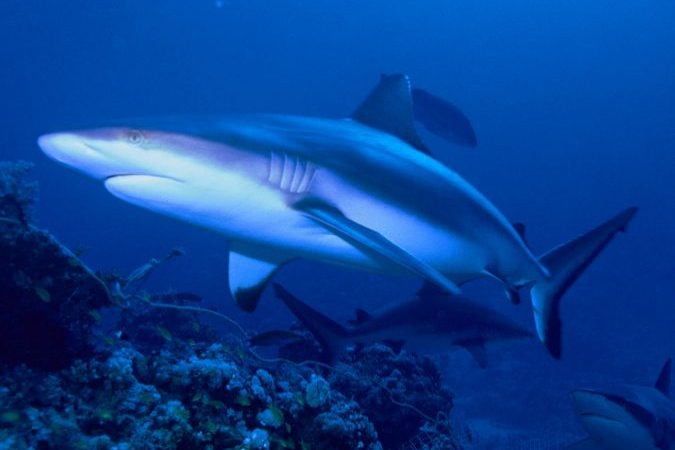Grey reef sharks, six-foot long on average and officially endangered, are an ordinary sight in Tubbataha Reef, a protected national marine park in Palawan. The existence of these sharks and their brethren are threatened by water pollution, shark fishing, and — more recently — by the sudden halt of marine wildlife tourism due to the pandemic.
Shark conservation efforts that depend on tourism income continue to struggle in 2021.
“Even though Tubbataha Reef is efficiently managed, sharks still can’t escape their threats,” said Anna R. Oposa, Executive Director of Save Philippine Seas (SPS), who shared that surveyors found a reef shark suffocated by a plastic bag this year. “If we can’t completely protect them here, what chance do they have in places that aren’t protected at all?”
Shark-based tourism is vital to the local economy and sharks themselves are essential to keeping marine ecosystems robust. Of the 1,000 shark species around the world, 200 can be found in the Philippines. Of these, only 25 are protected.
A shark study conducted in Tubbataha this year saw grey reef sharks, whitetips, and tiger sharks (including a three-meter specimen lingering in shallow water). “It shows Tubbataha is still doing very well,” said Maria Retchie C. Pagliawan, Tubbataha Reef National Park (TRNP) research officer, who shared the findings from their scientific trip at a virtual event organized by Marine Wildlife Watch of the Philippines (MWWP) and Save Philippine Seas (SPS).
“A Virtual Dive with Sharks” took viewers on a virtual underwater tour of Sulu Sea’s Tubbataha Reef and Negros Occidental’s Danjugan Island during Shark Awareness Week.
MWWP and SPS are both members of the Save Sharks Network, a coalition petitioning for the Philippine Shark Conservation Bill, introduced by Senator Risa N. Hontiveros-Baraquel in 2017, to be made into a law.
MARINE PROTECTED AREAS
In Negros Occidental, support for locally managed protected areas has been an issue, according to Kaila Ledesma-Trebol, a marine biologist and trustee of the Philippine Reef and Rainforest Conservation Foundation, Inc. (PRRCFI). The province is home to Danjugan Island, a marine sanctuary with lagoons, bat caves, limestone and mangrove forests, seagrass beds, and fringing coral reefs.
“We haven’t caught anyone here with sharks again like in the early 1990s, so that’s a good thing,” Ms. Ledesma-Trebol said, referring to dwindling cases of unsustainable shark fishing due to the practice being banned. “But in nearby Sipalay and other local markets in the mainland [of Negros], sharks still show up, and we know not all species are protected.”
Bought by PRRCFI in 1994 for conservation efforts, Danjugan Island is a marine haven in a region where ecological threats are rampant, boasting seven viable ecosystems that span limestone forests, caves, white-sand beaches, lagoons with mangroves, and coral reefs. Aside from conservation, Ms. Ledesma-Trebol and her team also hold marine wildlife camps that help connect people with nature (although these efforts are on hold due to the pandemic).
RETURN OF MARINE WILDLIFE TOURISM
While limited mobility prevents people from experiencing marine wonders firsthand, virtual trips and webinars on safe practices must do for now, according to Maria Rica C. Bueno, Department of Tourism (DoT) assistant secretary, who also spoke at the virtual dive event.
Quoting Tourism Secretary Bernadette Romulo-Puyat’s speech for World Environment Month in June, Ms. Bueno said: “Respecting the ocean and its inhabitants must be the top priority of every tourist who wants to connect with marine wildlife. Learning how to properly engage with these species is a small but crucial step in protecting and sustaining our marine biodiversity.”
The Joint Memorandum Circular No. 2020-01 (JMC) issued in 2020 establishes rules and regulations governing the conduct of marine wildlife tourism interaction in the Philippines. These include responsible behavior around marine animals while underwater, which they hope will be practiced when tourists return.
In Danjugan Island, “silent, patient, and undisruptive campers” have spotted as many as 80 blacktip reef shark pups while snorkeling in shallow reefs, said Ms. Ledesma-Trebol.
“If allowed, we will open camps again once the pandemic is over, but we will probably be doing private groups and not mix groups together,” she added, expressing hope for the return of marine wildlife tourism next year. “Of course, we have to do all the proper testing [for coronavirus disease 2019 (COVID-19)].” — Brontë H. Lacsamana

